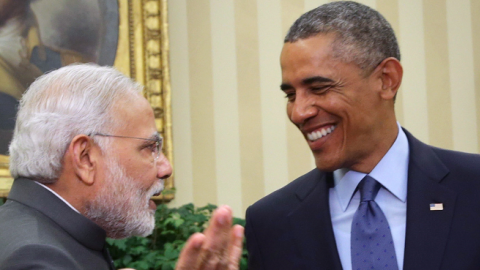U.S. President Barack Obama and Indian Prime Minister Narendra Modi met for the first time Sept. 29 in Washington, D.C. They are the latest in a line of American and Indian leaders - Bill Clinton and George W. Bush on one side, Atal Bihari Vajpayee and Manmohan Singh on the other - to push for closer ties between two of the world's most important democracies. The Indians have labeled it a natural partnership, and Americans have gone so far as to call it the defining partnership of the 21st century. In recent years, however high hopes have failed to materialize. Can this meeting begin to provide the boost this relationship needs?
On a visit to India in November 2010, President Obama said the United States "will not simply be cheering you on from the sidelines. We will be right there with you, shoulder to shoulder. Because we believe in the promise of India. And we believe that the future is what we make it." For Indians, Obama's speech was an acknowledgement of Indian history and showed that Washington has an appreciation for the independent path India took toward prosperity. There was optimism about growth in bilateral trade and increased defense cooperation. The two countries share similar threats from terrorism, have a common desire to defend the domains of cyber and outer space, and they share similar views of the global security architecture.
Four years on, though, and India's economic growth has slowed. Dreams of substantial Indian purchases of American equipment have not been fulfilled, and latent Nehruvian suspicion of American intentions have resurfaced.
Regional developments have also played a role. Continued American dependence on and military aid to Pakistan has deepened Indian wariness, and China is also a critical issue. New Delhi has a complex relationship with Beijing: China is at once a neighbor that has been a source of conflict, and a major economic partner. India prefers not to antagonize China, but it does compete for leadership across Asia, and New Delhi fears a world where China attains superpower status while India is shunted aside. Past discussions between Obama and former Chinese President Hu Jintao about a potential G-2 comprising China and the United States exacerbated Indian misgivings.
While in the United States, Modi has issued a pitch to three constituencies: the Indian-American diaspora, the U.S. business class and his own domestic voters. To the diaspora he has promised permanent visas and a reduction in bureaucracy. He set up a series of individual and group meetings with American corporate leaders and is vowing to reduce red tape and talking up potential incentives for investment. Pitching to constituents back home, his speeches have been peppered with descriptions of India's great past, its demographic dividend, and the need to improve sanitation, provide clean water and boost tourism to supplement local incomes.
Modi seeks to boost India's economic growth and he wants investment and support from the United States. Yet it remains unclear whether he will tackle the specific issues that have caused friction between the two countries - matters including intellectual property rights and India's nuclear liability law. Further, Modi's "Make in India" policy is aimed at boosting Indian manufacturing, though it would also welcome joint production with U.S. manufacturers. In the foreign security arena, how far will India see eye-to-eye with the United States on issues like Iran and Syria remains yet to be seen.




















